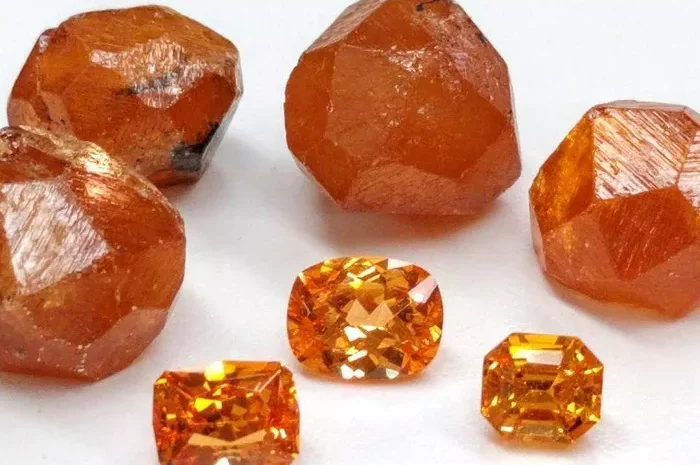Exploring the Geological Associations of a Precious Gemstone
Garnet, a captivating gemstone admired for its rich hues and exceptional brilliance, is not found in isolation but rather within specific types of rocks. Understanding the geological associations of garnet can provide valuable insights into its formation and distribution. In this article, we embark on a journey to explore the diverse types of rocks in which garnet is commonly found, shedding light on the fascinating geological contexts that give rise to this beloved gemstone.
Garnet: A Group of Minerals
Before delving into the rock types associated with garnet, it is crucial to recognize that garnet is not a single mineral but a group of closely related minerals. The garnet group encompasses several mineral species, including almandine, pyrope, spessartine, grossular, and andradite, each with its unique chemical composition and crystal structure. These variations in composition contribute to the diverse colors and properties exhibited by garnet gemstones.
Metamorphic Rocks: A Common Home for Garnet
Metamorphic rocks, formed through the transformation of pre-existing rocks under intense heat and pressure, are the primary host rocks for garnet. The metamorphic conditions necessary for garnet formation occur deep within the Earth’s crust, where rocks experience significant geological forces. Let us explore the various types of metamorphic rocks where garnet is commonly found.
1. Schist
Schist is a metamorphic rock characterized by its distinctive foliation, or layering, resulting from the alignment of minerals during metamorphism. Garnet schist, as the name suggests, is a schist rock that contains significant amounts of garnet. The abundance of garnet crystals within the schist gives it a striking appearance. Garnet schist can be found in various geological settings, such as regions with high-grade metamorphism and intense tectonic activity.
2. Gneiss
Gneiss is another type of metamorphic rock commonly associated with garnet. Similar to schist, gneiss exhibits a pronounced layering, known as gneissic banding, formed through the reorganization of minerals during metamorphism. The presence of garnet in gneiss can vary, ranging from sparse occurrences to extensive concentrations. The formation of garnet in gneiss is often associated with high-grade metamorphic conditions and the re-crystallization of pre-existing rocks.
3. Migmatite
Migmatite is a unique metamorphic rock that displays characteristics of both igneous and metamorphic rocks. It forms when rocks undergo partial melting during high-grade metamorphism. Within migmatite, the presence of garnet can occur in both the metamorphic and igneous portions of the rock. These garnet-bearing migmatites provide insights into the complex geological processes that involve both heat-induced metamorphism and the generation of new igneous material.
4. Amphibolite
Amphibolite is a metamorphic rock primarily composed of amphibole minerals, such as hornblende. Garnet can occur as an accessory mineral within amphibolite, often alongside other minerals like plagioclase feldspar and quartz. The formation of garnet in amphibolite is associated with intermediate to high-grade metamorphic conditions and the recrystallization of pre-existing rock material.
5. Eclogite
Eclogite represents a rare and intriguing type of metamorphic rock that forms under extreme pressure and temperature conditions in subduction zones. This rock is typically composed of garnet and omphacite, a variety of pyroxene. Eclogite is known for its distinctive dark green and red coloration, primarily attributed to the presence of garnet. The formation of eclogite occurs at great depths within the Earth’s mantle, providing a unique geological context for garnet formation.
Other Rock Types and Geological Associations
While garnet is predominantly associated with metamorphic rocks, it can also be found in certain igneous and sedimentary rock types. These occurrences, though less common, contribute to the overall understanding of garnet’s geological associations. Here are a few notable examples:
1. Igneous Rocks:
Granite and Pegmatite:
Garnet can be found as an accessory mineral within granite and pegmatite, which are coarse-grained igneous rocks. These occurrences of garnet are typically small and less abundant compared to those found in metamorphic rocks.
Lamprophyre:
Some lamprophyre rocks, which are mafic igneous rocks, can contain garnet as a minor mineral. These occurrences are less common but provide insights into the unique environments where garnet can crystallize during igneous processes.
2. Sedimentary Rocks:
Concentrated Heavy Mineral Deposits:
In certain sedimentary environments, such as placer deposits and river channels, garnet can accumulate as part of concentrated heavy mineral assemblages. These accumulations are the result of erosion, transport, and deposition processes that concentrate heavy minerals, including garnet.
Conclusion
Garnet, a captivating gemstone revered for its beauty and brilliance, is commonly found in association with specific rock types. Metamorphic rocks, such as schist, gneiss, migmatite, amphibolite, and eclogite, are the primary hosts for garnet, providing the necessary geological conditions for its formation. In addition to metamorphic rocks, garnet can also occur in certain igneous and sedimentary rocks, albeit less frequently.
By understanding the geological associations of garnet, we gain a deeper appreciation for the complex processes that shape our planet. From the intense pressures of metamorphism to the fiery depths of igneous processes, the presence of garnet within various rock types offers valuable insights into Earth’s geological history and the conditions that give rise to this remarkable gemstone.


